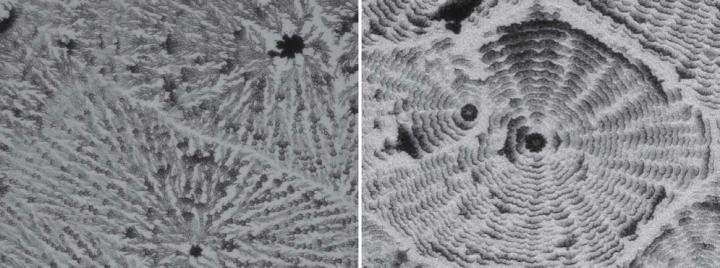Researchers control the drying patterns formed during salt recrystallization

Researchers from Tokyo Metropolitan University have discovered a new way of controlling the drying patterns formed by re-crystallizing salt. They found that the coffee ring effect can be used to pin the edge of drying droplets, creating a range of geometric patterns. The same principles may be applied to understand and improve the adhesion of printer ink to surfaces and the manufacture of film-based devices.
Anyone who has visited the beach notices that large chunks of salt form on their skin after a splash in the sea. These large, crystalline chunks are formed by re-crystallization as the sea water evaporates and leaves the salt behind. The drying of salt solution is actually a very complex phenomenon involving the interplay of many variables, including concentration and density profiles, heat transfer, and a wide range of environmental factors such as temperature and humidity. Understanding and controlling the mechanisms behind re-crystallization is crucial to understanding drying-related industrial processes like the adhesion of printer ink, the manufacture of devices based on thin films, and phenomena like salt damage in brick and the dissolving of pharmaceuticals in the human body.
Drying droplets of solid-laden solution often leaves large, uneven chunks deposited at the edge. This is a fairly common sight—consider the ring-like deposits left by spilt coffee. This so-called coffee ring effect is a result of different rates of evaporation on the top and at the edge of droplets, leading to a flow inside the droplet that drives an accumulation of solid particles at the edge. Ultimately, the droplet edge retracts, leaving a deposited ring. Though this effect is useful in concentrating the solute, it can be a nuisance when trying to produce a uniform coating.
A team from Tokyo Metropolitan University led by Associate Professor Rei Kurita has now shown that the same phenomenon can be leveraged to achieve a very different effect. By artificially adding microscopic latex particles to droplets of salt solution, they found that the coffee ring effect took particles to the edge, which subsequently pinned the droplet rim, keeping the droplet circular for the whole duration of the drying process as the salt re-crystallized. This led to the formation of beautiful, snowflake-like patterns, including dendritic, radial and concentric geometries, depending on temperature and humidity. The variety of behavior they uncovered is in stark contrast to the random re-crystallized chunks observed in drying droplets without these particulate additions. By systematically varying initial salt concentration and the evaporation rate, they found that they could tune the morphology. High initial concentrations and slower vaporization led to radial patterns, while the opposite led to ridged, concentric patterns.
Further to the promise of new ways of artificially controlling drying in a wide range of industrial processes, the team hopes to build on their success to gain a deeper understanding of the mechanisms behind the dynamic processes underpinning this fascinating phenomenon.
More information: Kouki Morinaga et al, Emergence of different crystal morphologies using the coffee ring effect, Scientific Reports (2018). DOI: 10.1038/s41598-018-30879-8
Journal information: Scientific Reports
Provided by Tokyo Metropolitan University





















